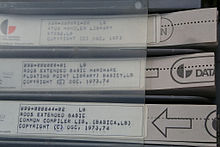


A business-oriented language needs to access and manipulate large amounts of record-structured data maintained externally.Accounting systems must be correct to the last decimal digit and need to reproduce exactly the results of hand-calculation conventional floating-point numbers lead to complexities and errors. Business and financial data needs to be managed using true decimal data types.Database programmers are familiar with some of these issues, and object-relational mapping tools trip over these complexities regularly. Business programs mix fixed and variable length strings, floating-point, integer, and decimal data with wild abandon in complicated record structures, often with variable parts. A business-oriented language needs to declare, manage, and manipulate heterogenous data.Robert Glass identified specific ways in which COBOL is better suited to business programming than general-purposes languages, among them: In modern terminology, COBOL is actually a domain-specific language, specific to the particular domain of business programming. A computer science student presented with COBOL would be appalled. You’d never want to write a compiler in COBOL. The most common forms of the language can’t use recursion. Any local talent will be expensive with their consulting fees.” Why is COBOL still dominant?Ĭompared to common programming languages today, COBOL is different, and in some ways very limited: you can’t do dynamic memory allocation, you can’t easily access low-level features of the operating system or particular computer architecture. The talent pool shifted from on-shore to off-shore. When IBM started remote work and outsourcing, they stopped incentivizing American schools to teach courses in Mainframes and COBOL. A very small amount of schools teach courses on mainframes and COBOL. “Individuals do not have the money to pay to lease a mainframe. “The mainframe is a very difficult platform to learn, and that’s due to the cost,” said Ceballos. In 1975, Edsgar Dijkstra famously proclaimed that “The use of COBOL cripples the mind its teaching should, therefore, be regarded as a criminal offence.” This undoubtedly led to the decline of teaching COBOL in universities, but it remained the dominant business language.īut finding people with COBOL skills can be tough. COBOL is meant to be explicit, because there shouldn’t be room for assumptions.”

#DATA PUNCH TAPE CREATOR SOFTWARE#
Mario Ceballos, a software engineer at Cigna, told me, “The syntax is kept simple to allow non-programmers (“The Business”) to read it and understand it. Plenty of companies still use COBOL, including IBM, UPS, and Cigna. The resulting language went through more revisions, but rapidly became the dominant language for building business systems, and it has remained dominant since. That group came to be called CODASYL-the Committee on Data Systems Languages-and defined a “common business oriented language,” drawing from Grace Hopper’s FLOW-MATIC, and other languages including Univac’s AIMACO and IBM’s COMTRAN.

One of the first of the high-level languages, it was put together by a group sponsored by the Department of Defense to develop a common business language. COBOL? What’s this COBOL?ĬOBOL stands for COmmon Business Oriented Language.
#DATA PUNCH TAPE CREATOR CODE#
So, how can you learn COBOL, make big bucks, and save lots of state agencies that need new code to deal with all the new government stimulus programs? New Jersey Governor Phil Murphy made a television appearance to plead for COBOL programmers to help. So they’re operating on really old stuff.” This (virus) interfered and they had to cease the transition to a much more robust system. “Our Department of Labor had recognized that that was an issue and had initiated modernization, and, unfortunately, that’s something that takes time. You know very, very old technology,” Kelly said Tuesday. “So many of our Departments of Labor across the country are still on the COBOL system. Now, in 2020, governments and banks are pleading for COBOL programmers, the language that wouldn’t die. By the 80’s, students were being told that COBOL was a dead language, and no one was studying it any more. Once upon a time, when the world and computers were new, I was in an Associate’s Degree program for Data Processing-there were no “computer science” programs then-in which I had to study accounting, math, statistics, and three computer languages: IBM/360 Basic Assembly Language, FORTRAN, and COBOL.


 0 kommentar(er)
0 kommentar(er)
